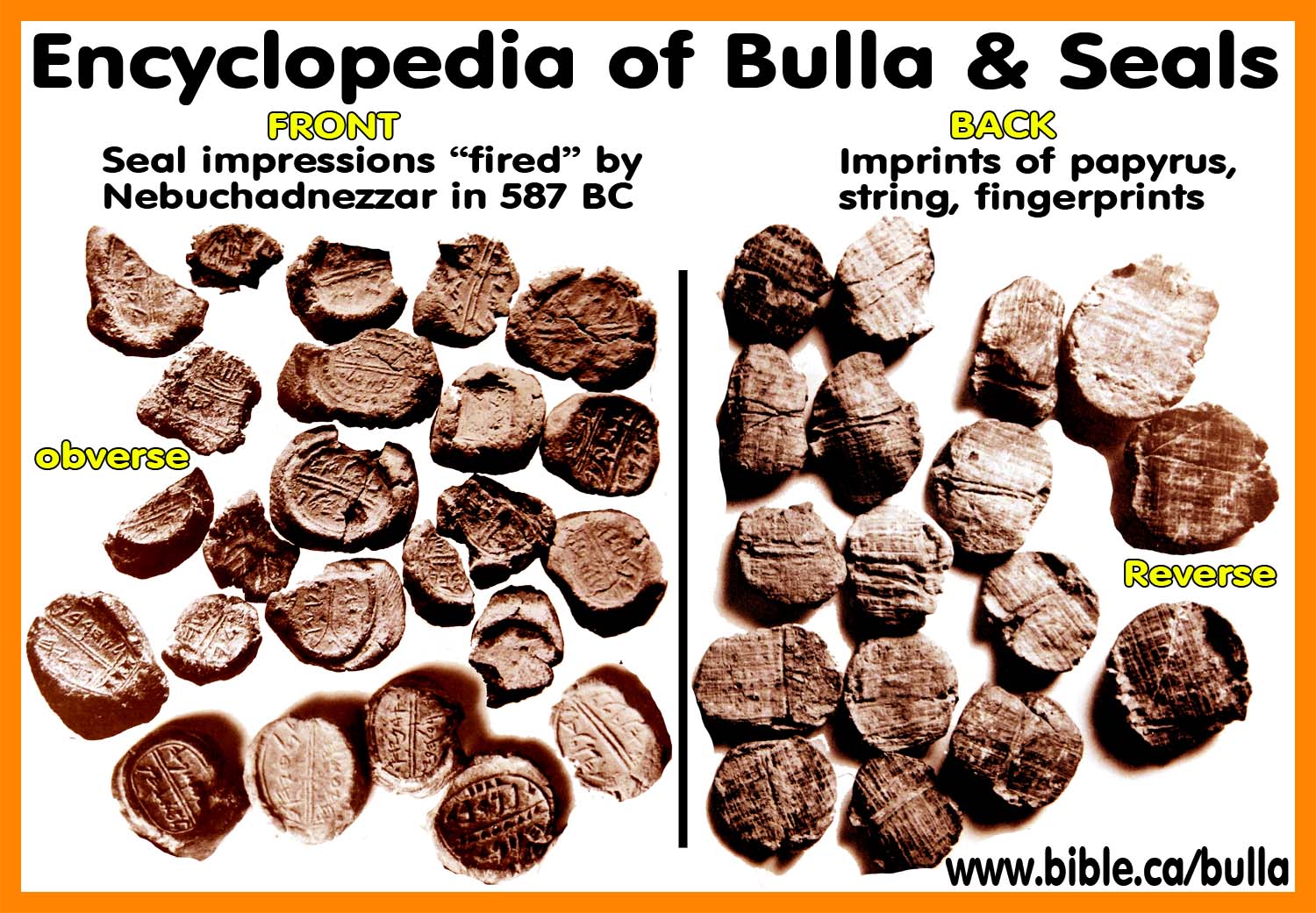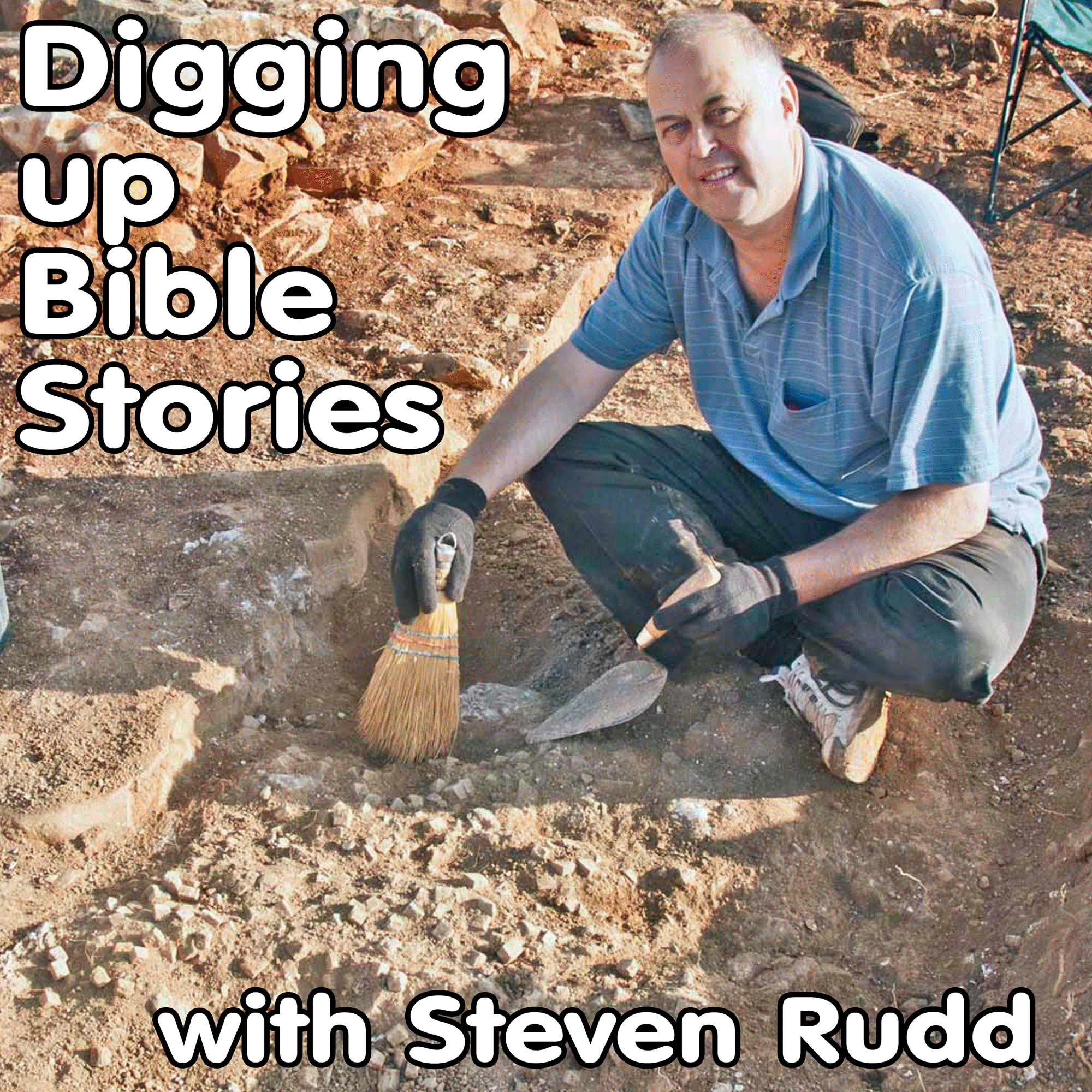Seal of Hananiah son of Azariah, False prophet
Bible Bullae from Israel and Judah
|
Bulla of Hananiah son of Azariah "Archaeologists are digging up bible stories!!!" 1. Glyptic artifact: Seal of unknown substance 2. Inscription: "Belonging to Hananiah son of Azariah" 3. Provenance: None: Private antiquities market 1982 AD. 4. Current location: Museum of Western Asiatic Antiquity, Berlin 5. Date: 595 BC 6. Bible verses: Jer 28:1-17 7. Events: During the reign of Zedekiah in the fall of 595 BC. |
|
|
||||||
|
Encyclopedia of Bullae and Seals: The Exhibit: On-line Museum of Bulla and seals Security: How bullae are made to seal papyrus Forgeries: Known fake bullae and seals |
||||||
|
|
||||||
|
Archaeologists are digging up bible stories!!! |
||||||
|
Archaeology is an important science that confirms the historical accuracy of the Bible. Since the Bible refers to hundreds of cities, kings, and places, we would expect to find evidence from on-site excavations. And this is exactly what we have found. The Bible is the most historically accurate book of history on earth. Read the Bible daily! |
|
|||||
|
|
||||||
Encyclopedia of Bullae and Seals of Judea and Israel
|
Bulla "belonging to Hananiah son of Azariah" 1. Glyptic artifact: Seal of unknown substance 2. Inscription: "Belonging to Hananiah son of Azariah" 3. Provenance: None: Private antiquities market 1982 AD. 4. Current location: Museum of Western Asiatic Antiquity, Berlin 5. Date: 595 BC 6. Bible verses: Jer 28:1-17 7. Events: During the reign of Zedekiah in the fall of 595 BC. |
Bible text:
"In that same year, at the beginning of the reign of King Zedekiah of Judah, in the fifth month of the fourth year, the prophet Hananiah son of Azzur [Azaraiah], from Gibeon, spoke to me in the house of the Lord, in the presence of the priests and all the people, saying, “Thus says the Lord of hosts, the God of Israel: I have broken the yoke of the king of Babylon. Within two years I will bring back to this place all the vessels of the Lord’s house, which King Nebuchadnezzar of Babylon took away from this place and carried to Babylon. I will also bring back to this place King Jeconiah son of Jehoiakim of Judah, and all the exiles from Judah who went to Babylon, says the Lord, for I will break the yoke of the king of Babylon.” Then the prophet Jeremiah spoke to the prophet Hananiah in the presence of the priests and all the people who were standing in the house of the Lord; and the prophet Jeremiah said, “Amen! May the Lord do so; may the Lord fulfill the words that you have prophesied, and bring back to this place from Babylon the vessels of the house of the Lord, and all the exiles. But listen now to this word that I speak in your hearing and in the hearing of all the people. The prophets who preceded you and me from ancient times prophesied war, famine, and pestilence against many countries and great kingdoms. As for the prophet who prophesies peace, when the word of that prophet comes true, then it will be known that the Lord has truly sent the prophet.” Then the prophet Hananiah took the yoke from the neck of the prophet Jeremiah, and broke it. And Hananiah spoke in the presence of all the people, saying, “Thus says the Lord: This is how I will break the yoke of King Nebuchadnezzar of Babylon from the neck of all the nations within two years.” At this, the prophet Jeremiah went his way. Sometime after the prophet Hananiah had broken the yoke from the neck of the prophet Jeremiah, the word of the Lord came to Jeremiah: Go, tell Hananiah, Thus says the Lord: You have broken wooden bars only to forge iron bars in place of them! For thus says the Lord of hosts, the God of Israel: I have put an iron yoke on the neck of all these nations so that they may serve King Nebuchadnezzar of Babylon, and they shall indeed serve him; I have even given him the wild animals. And the prophet Jeremiah said to the prophet Hananiah, “Listen, Hananiah, the Lord has not sent you, and you made this people trust in a lie. Therefore thus says the Lord: I am going to send you off the face of the earth. Within this year you will be dead, because you have spoken rebellion against the Lord.” In that same year, in the seventh month, the prophet Hananiah died." (Jeremiah 28:1–17)
Introduction:
1.
The story about the false prophet Hananiah son of Azariah from Gibeon is
found in Jeremiah 28.
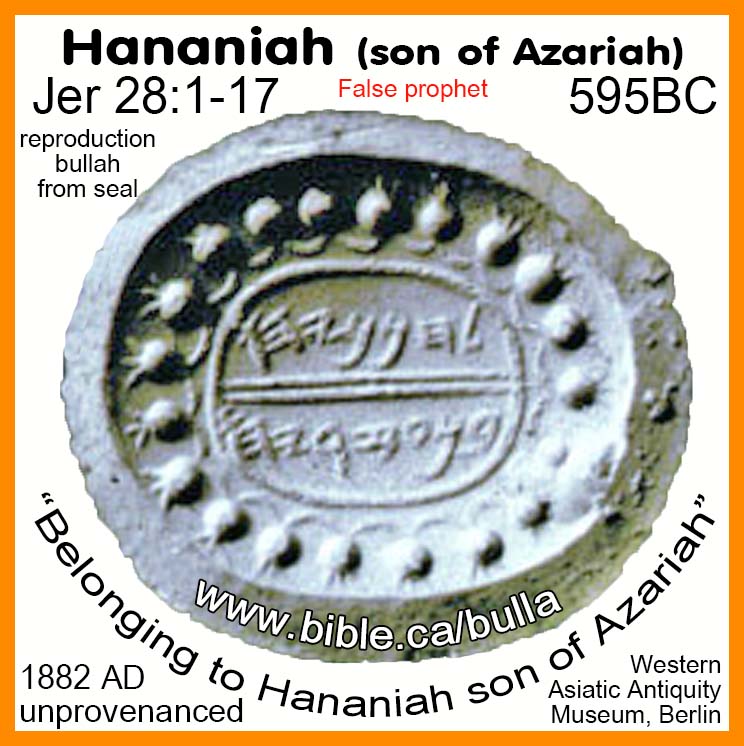
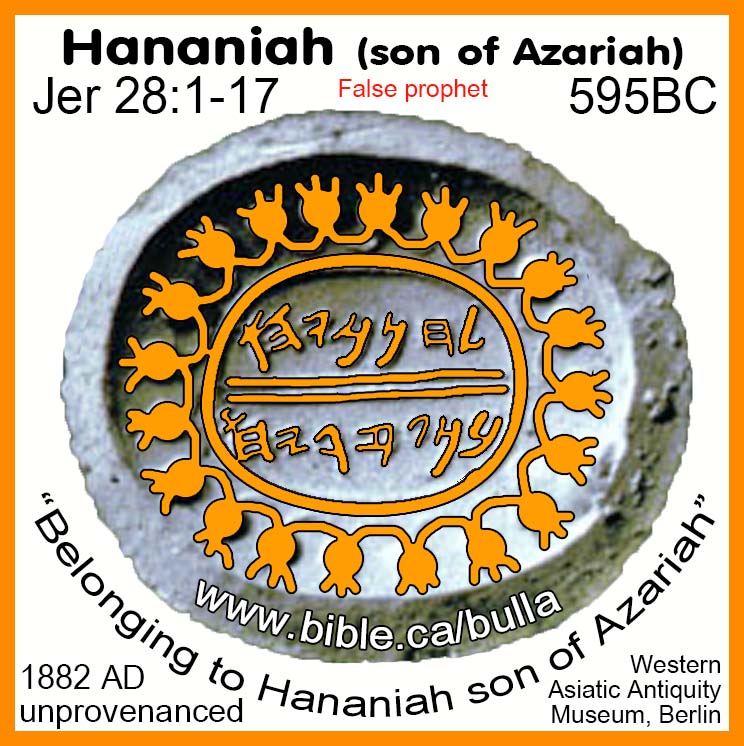
2. Hananiah was corrupt and faithless and used his position in the Naioth preachers school to his own power, prestige and of course money.
3. He likely the head prophet of the institutional, certified "mainline certified" prophets from Gibeon and Ramah:
a.
Around 1030-1014 BC Samuel's ancient prophets school called
"Naioth", is located at Ramah, which overlooks Gibeon less than 1 km
to the north: "Now David fled and escaped and came to Samuel at Ramah, and
told him all that Saul had done to him. And he and Samuel went and stayed in
Naioth. It was told Saul, saying, “Behold, David is at Naioth in Ramah.”"
(1 Samuel 19:18–19)

b.
In 1010 BC Gibeon is where Joab, the army general of David and Abner,
the army general of Saul's son Ish-bosheth invented the battle strategy used in
the Battle of 1812AD where Canada womped the USA in war and sent the running
home to Dixie: "Now Abner the son of Ner, went out from Mahanaim to Gibeon
with the servants of Ish-bosheth the son of Saul. And Joab the son of Zeruiah
and the servants of David went out and met them by the pool of Gibeon; and they
sat down, one on the one side of the pool and the other on the other side of
the pool. Then Abner said to Joab, “Now let the young men arise and hold a
contest before us.” And Joab said, “Let them arise.” So they arose and went
over by count, twelve for Benjamin and Ish-bosheth the son of Saul, and twelve
of the servants of David. Each one of them seized his opponent by the head and
thrust his sword in his opponent’s side; so they fell down together. Therefore
that place was called Helkath-hazzurim, which is in Gibeon." (2 Samuel
2:12-16)
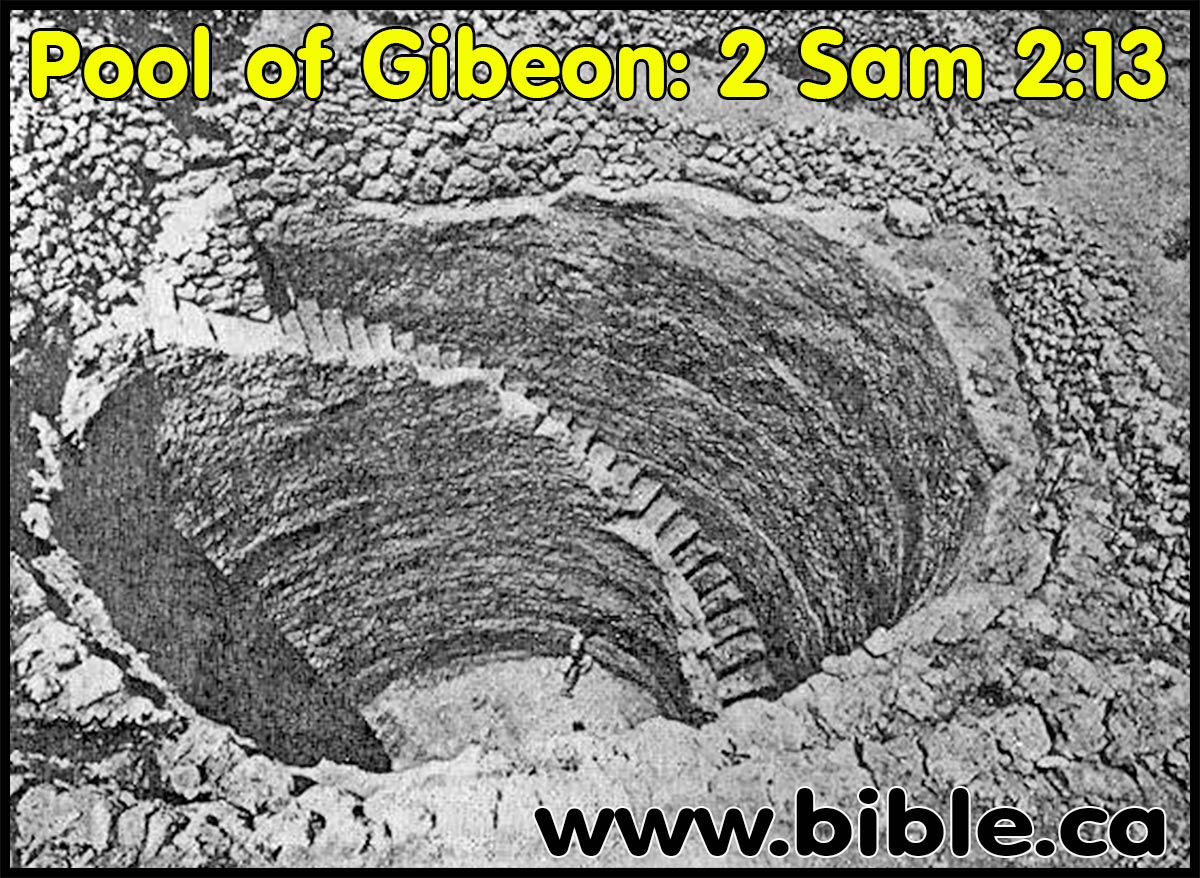
c.
Gibeon is the location of the Tabernacle of Moses from 1018-960 BC. Saul
killed all the priests at Nob and then moved the tabernacle of Moses to Gibeon
in 1018 BC.
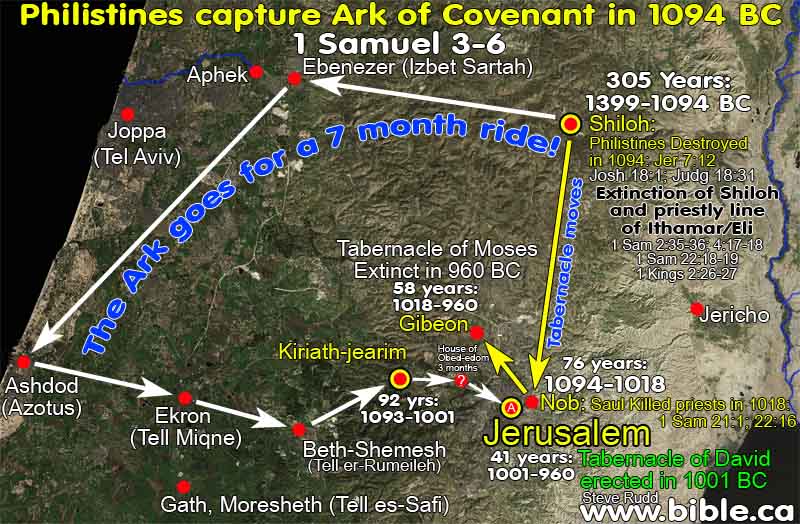
d.
Gibeon was used by the kings as a royal city. When the tabernacle of
Moses was taken down the put in the storerooms of the temple of Solomon the
former important real estate of the "Gibeon temple mount" became a
residence for the elite among the prophets and servants of the King. This
probably explains why the head prophet of Israel came from Gibeon. They have
found many pottery stamps with LMK "for the king" in the excavations
there.

e. So Hananiah was likely the leading prophet instructor of the now corrupt and institutionalized prophets school that Samuel founded.
I. Archeological information about the seal of Hananiah son of Azariah: Unprovenanced
1. In 1980 AD a seal surfaced on the private antiquities market in Jerusalem and are currently housed at the Western Asiatic Department of the State Museums at Berlin (VA 32).
a. We do not have any photos of the seal, only a replica bulla made from the ancient seal.
b. We do not know what the seal is made of or where it originated from.
2. "SEALS WITH FLORAL DECORATIONS There are also some seals with floral decoration. Two elegantly engraved signets, which were found in Jerusalem, are preserved in the Western Asiatic Department of the State Museums at Berlin (VA 32 and 33). On VA 32, the inscription in two lines, separated by the usual double line, is surrounded by an oval line. All round this oval line there is a rather unusual decoration of pomegranates. This fruit, called in Hebrew rimmon, is often mentioned in the O.T. (Deut. viii.8 ; Joel i.12 ; Songs viii.2, etc.). Pomegranates figure in the ornamentation of the priestly robes (Exod. xxviii.33, etc.) and in the carv- ings of the Temple (t Kings vii.18, etc.), and their beauty is alluded to in Song iv.3, 13, etc. The inscription reads thus: Ihnnvhw bn'zyrhw: belonging to Hananiali son of Azariah." Both names occur in the O.T. (e.g. Jer. xxviii. 1 ; 2 Kings xv.6, 8). Curiously enough, VA 33 presents many features analogous to those of VA 32. It too contains an inscription in two lines separated by a double line ; the engraved face is surrounded by an oval line ; the name of the owner is the same, but not the patronymic ; and it is very elegantly engraved. Its floral decoration is, however, different. It is divided into three zones, the upper one, separated from the rest by a double line, containing a seven-leaved palmette. A nearly identical decoration is found on a fragment which belonged to a stone decorative frieze of the synagogue at Chorazin (Khirbet Kerazeh), to the north of the Sea of Gennesaret, though the seal is probably nine hundred years older than the synagogue. The inscription reads : lhnnyhw ' (Belonging) to Hananiah bnlbr son of Achbor' Of particular interest is the name Achbor 'mouse' (2 Kings xxii.I2), names of animals being rare in inscriptions. (Documents from Old Testament Times: Ancient Texts and Translations, D. Winton Thomas, p 225, 2006 AD)
I. Nebuchadnezzar's Dream and the golden statue he built:
1. In 602 BC Daniel interprets the dream of Nebuchadnezzar's 5 succeeding world kingdoms statue where he is the head of gold. (Babylon, Medo-persia, Greece, Rome, Church.)
2. In 603 BC Nebuchadnezzar begins construction of his golden image statue that measures 3 wide x 30 meters high. (6x60 cubits)
a. "Nebuchadnezzar the king made an image of gold, the height of which was sixty cubits and its width six cubits; he set it up on the plain of Dura in the province of Babylon." (Daniel 3:1)
3. In spring of 595 BC Nebuchadnezzar orders every vassal world leader under his domain, including Zedekiah, to attend the official unveiling of the golden image in Babylon.
a. "Then Nebuchadnezzar the king sent word to assemble the satraps, the prefects and the governors, the counselors, the treasurers, the judges, the magistrates and all the rulers of the provinces to come to the dedication of the image that Nebuchadnezzar the king had set up." (Daniel 3:2)
4. In October 595 BC Zedekiah and Seraiah his quartermaster, leave Jerusalem to make the trip to Babylon for the dedication of the golden image of Nebuchadnezzar in the plain of Dura outside of Babylon.
a. "The message which Jeremiah the prophet commanded Seraiah the son of Neriah, the grandson of Mahseiah, when he went with Zedekiah the king of Judah to Babylon in the fourth year of his reign. (Now Seraiah was quartermaster.) So Jeremiah wrote in a single scroll all the calamity which would come upon Babylon, that is, all these words which have been written concerning Babylon. Then Jeremiah said to Seraiah, “As soon as you come to Babylon, then see that you read all these words aloud, and say, ‘You, O Lord, have promised concerning this place to cut it off, so that there will be nothing dwelling in it, whether man or beast, but it will be a perpetual desolation.’ “And as soon as you finish reading this scroll, you will tie a stone to it and throw it into the middle of the Euphrates, and say, ‘Just so shall Babylon sink down and not rise again because of the calamity that I am going to bring upon her; and they will become exhausted.’ ” Thus far are the words of Jeremiah." (Jeremiah 51:59-64)
b.
Seraiah part of the scribal family and was the brother to Baruch,
Jeremiah's scribe who wrote the scroll that Jehoiakim burned in 605 BC.
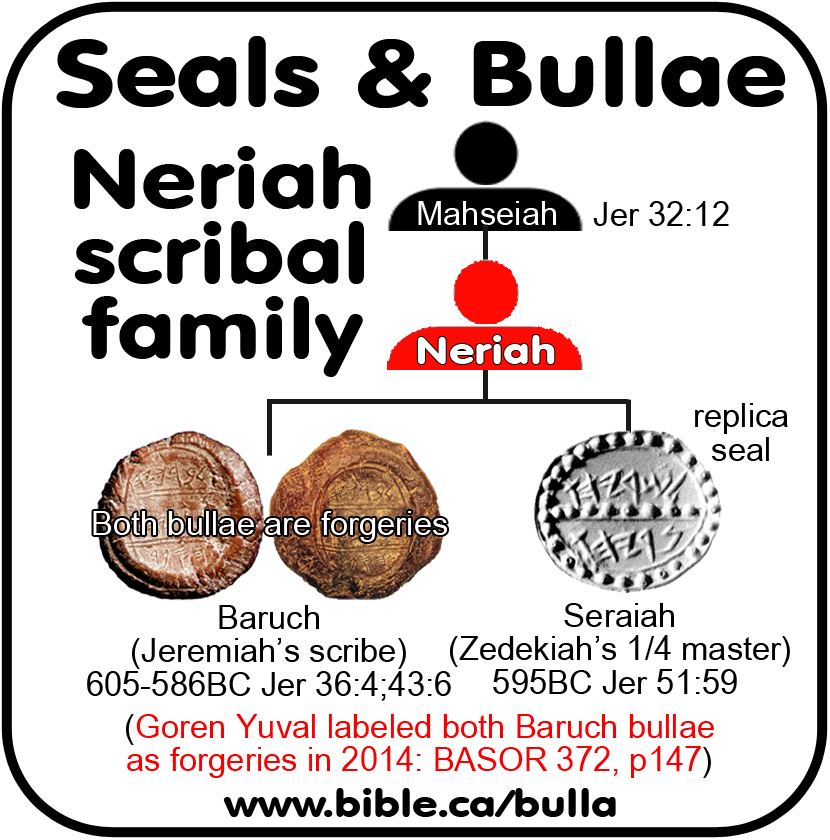
II. Zedekiah's front row seat at Nebuchadnezzar's dedication ceremony:
1. In spring of 595 BC, Nebuchadnezzar dedicates his golden image ceremony and everyone must bow down when the musical instruments start playing.
a. Zedekiah would have been in the front row with the other heads of state under Nebuchadnezzar's control.
b. Zedekiah surely bowed down to worship the statue.
c. Meanwhile Shadrach, Meshach, Abed-nego refuse to bow down and are thrown into the fiery furnace in Nebuchadnezzar's rage.
2. In spring of 595 BC, when Nebuchadnezzar saw the angel who saved Shadrach, Meshach, Abed-nego from death
a. He brought Zedekiah, along with the other world leaders to witness first hand the miracle and meet in person Shadrach, Meshach, Abed-nego.
b. Zedekiah likely shook the hands or hugged or kissed Shadrach, Meshach, Abed-nego after God saved them: "The satraps, the prefects, the governors [Zedekiah would certainly be there] and the king’s high officials gathered around and saw in regard to these men that the fire had no effect on the bodies of these men nor was the hair of their head singed, nor were their trousers damaged, nor had the smell of fire even come upon them." (Daniel 3:27)
c. Nebuchadnezzar proclaimed faith in YHWH: "Nebuchadnezzar responded and said, “Blessed be the God of Shadrach, Meshach and Abed-nego, who has sent His angel and delivered His servants who put their trust in Him, violating the king’s command, and yielded up their bodies so as not to serve or worship any god except their own God. “Therefore I make a decree that any people, nation or tongue that speaks anything offensive against the God of Shadrach, Meshach and Abed-nego shall be torn limb from limb and their houses reduced to a rubbish heap, inasmuch as there is no other god who is able to deliver in this way.”" (Daniel 3:28-29)
3. Zedekiah vs. Nebuchadnezzar:
a. Nebuchadnezzar was a pagan idol worshipper.
b. Zedekiah sat on the throne of YHWH: "Then Solomon sat on the throne of the Lord as king instead of David his father; and he prospered, and all Israel obeyed him." (1 Chronicles 29:23)
c. It is very sad that Zedekiah who sat on the very throne of Yaweh DID NOT BELIEVE IN YAWEH.
d. It is shocking that the king of Israel who bowed down to Nebuchadnezzar's golden pagan god image had to learn from a pagan king that you should not worship idols but God (YHWH) alone!
e. What an incredible rebuke of Zedekiah that must have been humiliating!
III. Hananiah encourages Zedekiah to rebel against Nebuchadnezzar
1. In July 595 BC Zedekiah arrived home in Jerusalem and rebels against Nebuchadnezzar because of the false prophecies of Hananiah son of Azariah!
a. A great show down between false prophet Hananiah and Jeremiah erupts.
b. This showdown was every bit as spectacular as the one on Mt. Carmel where Elijah challenges the 850 false prophets of Baal.
c. Jeremiah is told by God to make a wooden yolk and wear it on his neck as an warning allegory to Edom, Moab, Ammon, Tire, Sidon and Zedekiah in Jerusalem that they MUST SERVE Nebuchadnezzar.
d. Hananiah takes the wooden yolk of Jeremiah, smashes it on the floor in front of king Zedekiah and prophecies falsely that in two years God will smash the yolk of Babylon from the neck of the nations and all the temple vessels will be returned to Jerusalem.
e. Jeremiah says that Hananiah will die for his false prophecy and now the yolk which Zedekiah will wear when he is deported to Babylon will be bronze not wood.
2. In September 595 BC Hananiah dies two months after Jeremiah condemned him to death.
Conclusion:
1. On Tuesday 27 January 598 BC Nebuchadnezzar begins his attack on Jerusalem: Ezek 24:1-2; 2 Ki 25:1
- "And the word of the Lord came to me in the ninth year, in the tenth month, on the tenth of the month, saying, “Son of man, write the name of the day, this very day. The king of Babylon has laid siege to Jerusalem this very day." (Ezekiel 24:1–2)
- "Now in the ninth year of his reign, on the tenth day of the tenth month, Nebuchadnezzar king of Babylon came, he and all his army, against Jerusalem, camped against it and built a siege wall all around it." (2 Kings 25:1)
- On Saturday 29 July 587 BC Babylon breeches the walls of Jerusalem and Zedekiah flees but is captured near Jericho taken to Riblah where is sons are executed in front of him, his eyes are gouged out and he is deported to Babylon in bronze chains just like Jeremiah prophesied. 2 Ki 25:2-4; Jer 52:7-11; Ezek 33:21; 40:1
- "So the city was under siege until the eleventh year of King Zedekiah. On the ninth day of the fourth month the famine was so severe in the city that there was no food for the people of the land. Then the city was broken into, and all the men of war fled by night by way of the gate between the two walls beside the king’s garden, though the Chaldeans were all around the city. And they went by way of the Arabah." (2 Kings 25:2–4)
- "Then the city was broken into, and all the men of war fled and went forth from the city at night by way of the gate between the two walls which was by the king’s garden, though the Chaldeans were all around the city. And they went by way of the Arabah. But the army of the Chaldeans pursued the king and overtook Zedekiah in the plains of Jericho, and all his army was scattered from him. Then they captured the king and brought him up to the king of Babylon at Riblah in the land of Hamath, and he passed sentence on him. The king of Babylon slaughtered the sons of Zedekiah before his eyes, and he also slaughtered all the princes of Judah in Riblah. Then he blinded the eyes of Zedekiah; and the king of Babylon bound him with bronze fetters and brought him to Babylon and put him in prison until the day of his death." (Jeremiah 52:7-11)
- "Now in the twelfth year of our exile, on the fifth of the tenth month, the refugees from Jerusalem came to me, saying, “The city has been taken.”" (Ezekiel 33:21)
- "In the twenty-fifth year of our exile, at the beginning of the year, on the tenth of the month, in the fourteenth year after the city was taken, on that same day the hand of the Lord was upon me and He brought me there." (Ezekiel 40:1)
- "(135) Now the city was taken on the ninth day of the fourth month, in the eleventh year of the reign of Zedekiah. They were indeed only generals of the king of Babylon, to whom Nebuchadnezzar committed the care of the siege, for he abode himself in the city of Riblah. The names of these generals who ravaged and subdued Jerusalem, if anyone desire to know them, were these: Nergal Sharezer, Sangar Nebo, Rabsaris, Sarsechim, and Rabmag; (136) and when the city was taken about midnight, and the enemy’s generals were entered into the temple, and when Zedekiah was sensible of it, he took his wives and his children, and his captains and friends, and with them fled out of the city, through the fortified ditch, and through the desert; (137) and when certain of the deserters had informed the Babylonians of this, at break of day, they made haste to pursue after Zedekiah, and overtook him not far from Jericho, and encompassed him about. But for those friends and captains of Zedekiah who had fled out of the city with him, when they saw their enemies near them, they left him and dispersed themselves, some one way and some another, and every one resolved to save himself; (138) so the enemy took Zedekiah alive, when he was deserted by all but a few, with his children and his wives, and brought him to the king. When he was come, Nebuchadnezzar began to call him a wicked wretch, and covenant-breaker, and one that had forgotten his former words, when he promised to keep the country for him. (139) He also reproached him for his ingratitude, that when he had received the kingdom from him, who had taken it from Jehoiachin, and given it him, he had made use of the power he gave him against him that gave it: “but,” said he, “God is great, who hateth that conduct of thine, and hath brought thee under us.” (140) And when he had used these words to Zedekiah, he commanded his sons and his friends to be slain, while Zedekiah and the rest of the captains looked on; after which he put out the eyes of Zedekiah, and bound him, and carried him to Babylon. (141) And these things happened to him, as Jeremiah and Ezekiel had foretold to him, that he should be caught, and brought before the king of Babylon, and should speak to him face to face, and should see his eyes with his own eyes; and thus far did Jeremiah prophesy. But he was also made blind, and brought to Babylon but did not see it, according to the prediction of Ezekiel." (Josephus Antiquities 10.135-140)
- Hananiah was proven a false prophet and the words of Jeremiah came true when Zedekiah was blinded at Riblah and hauled off to Babyon in chains.
- "The king of Babylon slaughtered the sons of Zedekiah before his eyes, and he also slaughtered all the princes of Judah in Riblah. Then he blinded the eyes of Zedekiah; and the king of Babylon bound him with bronze fetters and brought him to Babylon and put him in prison until the day of his death." (Jeremiah 52:10-11)
By Steve Rudd: Contact the author for comments, input or corrections.
